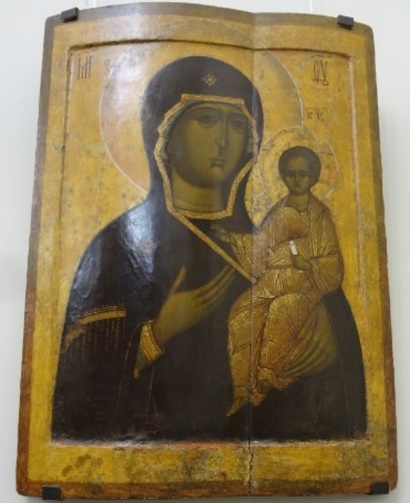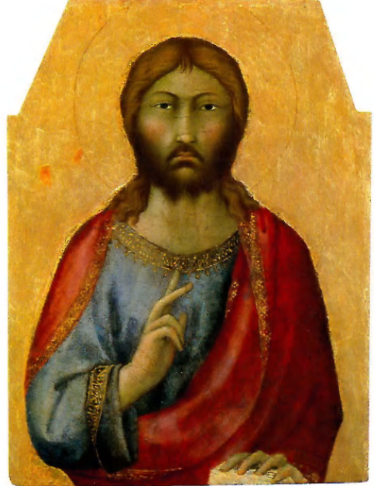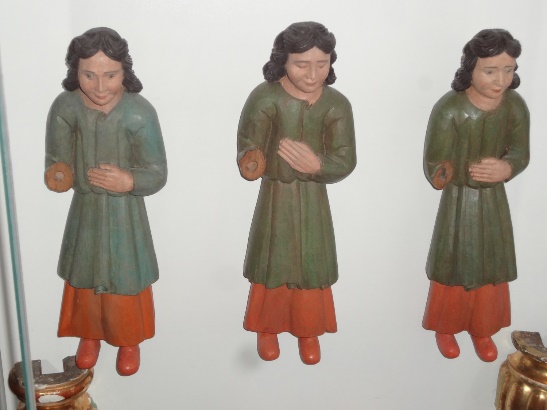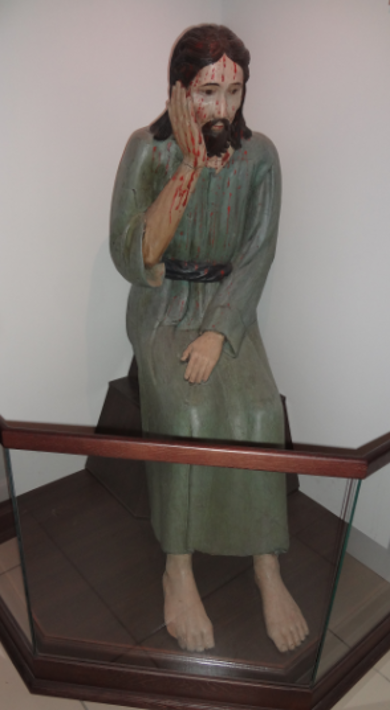Abstract
The paper analyzes the color palette of icons and orthodox sculpture from the funds of the Perm State Art Gallery, which was created for Christianization of the Finno-Ugrian population of the Urals and Siberia. Among the analyzed items the authors paid special attention to icons of the Virgin Mary and Jesus Christ painted in green color palette. The authors consider several origins of this phenomenon. During the study the authors found the funds of the Picture Gallery of the Vatican Museums containing a similar orthodox icon of Jesus with a green face and Mongolian appearance, but with a glow that excludes the version of paint defect and correlates green faces on icons to Islam. The study showed that green faces of the Virgin Mary and Jesus Christ were painted on icons in the Siberian-Ural region only in the 17th century. The analysis of all exhibits confirmed the following tendency: during this period the demonstrative use of green color on icons and orthodox sculptures, including background, icon setting, chitons and other significant elements reached 100% having sharply decreased in the 18th and 19th centuries according to canonical injunctions. The studied exhibits reflected an ethnic component of the local people: domination of green color is present on the images of Jesus, Saints, angels whose appearance resembles the Turkic people, the Finno-Ugrian. This confirms that in the 17th century the Islam and its green color were quite well familiar to the entire population of the studied region, not just to Turkic-Tatar groups.
Keywords: IslamFinno-UgriansUralsSiberiaiconsorthodox sculpture
Introduction
At present, the cultures of some Finno-Ugrian people of the Urals and Siberia are characterized by the increased number of mixed marriages with Muslims. This phenomenon is present in regions where the Finno-Ugrians have the status of indigenous ethnic groups of the North, in particular, in Khanty-Mansiysk Autonomous District – Yugra. Muslim migrants from the republics of the former Soviet Union were getting married with the peoples of the North thus obtaining not only the Russian citizenship, but also the right for numerous privileges within the family: housing, allowances, etc. It increases the population of mixed marriages and promotes the penetration of Islam into traditional beliefs of the peoples of the North. One short time interval, during which the Ugrian people borrowed new cultural norms, deserves special attention. This suggests the existence of earlier knowledge of Islam in their life, which once was considered as habitual, but was lost.




Problem Statement
The population of the Russian state historically consists of the representatives of different faiths, the most numerous of which practice Orthodoxy and Islam. Having formed at the end of the 15th century under the influence of Tatar-Mongolian cultural, Russia in the 16th century included Kazan, Astrakhan and Siberian khanates thus predetermining its future development in close connection with Islam. Besides Turkic people, the population contained various Finno-Ugrian groups, which were earlier under the influence of the Medieval Muslim states. Turkization of some Finno-Ugrian people most probably triggered the religious influence – Islamization. Pursuing the missionary policy in the attached lands since the end of the 16th century the Russian Orthodox Church faced the fact that some Finno-Ugrian people, which were considered pagan, know and use the norms of Islam. The tercentenary policy of Christianization displaced Islam from Finno-Ugrian cultures, but its traces remained for some time not only in mentality and customs of these people, but also in the objects of the orthodox cult. At the end of the 16th century the Stroganov icon-painting workshops were open in Perm Krai, from which icons were distributed across the Urals and Western Siberia. The missionaries considered “former” religion of the natives and skillfully used its images in icon-painting and orthodox sculpture. The funds of the Perm State Art Gallery contain the collection of icons and sculptural images with expressed domination of green color that during the considered period was not generally typical for Orthodoxy and was not fixed in icon-painting canons. This phenomenon makes it possible to state the hypothesis on the unequivocal use of Islam color for more successful missionary outreach.
Research Questions
Islam in the culture of the Finno-Ugrian people did not yet become a matter of interest. At present, the authors published only one article illustrating the general problem statement (Naumenko & Naumenko, 2018); other scientists considered climatic, geographical, economic and sociocultural conditions of Siberian-Ural region with active religious borrowings (Bogomolova, Takmashеva, Araslanov, & Zelinskaya, 2017; Bortnikova, Naumenko, & Naumenko, 2016; Bulgakova, 2016; Crate, 2014; Moldanova, 2006; Prokhorova, 2012; Tkachev, Fedulov, Moldanova, & Tkacheva, 2018). The probability of Islamization of the Finno-Ugrian people from the Medieval Muslim states is very high and can be considered as the need and the possibility of this process. The need was caused by missionary work, which in general is typical for Islam, and the possibility included a whole complex of factors based on natural and geographic features of the region, its political and confessional history. Since ancient times the Finno-Ugrian people living in the territory of the Urals were under the long-time influence of the Muslim Volga Bulgaria thus having various contacts with them (Krylasova, Ilyin, & Bryukhova, 2011). As for Western Siberia, at the end of the 14th century (according to other sources – 12th century) the Sufi Order Naqshbandiyah arrived to Siberia from the Central Asia with the missionary purpose. It is considered that since this period the Siberian Tatars accepted Islam (Maslyuzhenko, 2015). The Sufi moved down large rivers of Western Siberia, and the sources recorded the presence of Muslim names of Finno-Ugrian people on their coast. According to Glavatskaya (2009), “Islam was mainly accepted or largely experienced by the groups of yasachny people of the Verkhoturye County came under its influence substantially (“Ostyak” of volosts “on Mulgae”; “Ostyak”, “Tatars” and “Tersyak” of volosts “in the field over the Ayah lake”, “top of the Chusovy river” and two volosts called “top of the Ufa river” (p. 103)). Among the population of the Pelymsky County the Tabarinsky, Tavdinsky and partly Kondinsky “Voguls”/ “Tatars” were subject to Turkization, and with high degree of probability, Islamization. Besides, the Ob Ugrian had close relations with Siberian khanate: trade, military alliances, mixed marriages and so forth, and the ethnogenetic study showed the existence of common anthropological roots of the Ob Ugrian and the Siberian Tatars of the Tobol-Irtysh group (Agdzhoyan, Balanovskaya, Padyukova, & Bolsunova, 2016). These circumstances allow confirming the existence of Islam in the life of some groups of the Finno-Ugrian people up to the 17th-18th centuries.
Purpose of the Study
The purpose of the study is to identify Islam traces in the collections of orthodox sculpture and iconography kept in the funds of the Perm State Art Gallery.
Research Methods
The Frontier Thesis (Turner, 1962) and its implementation in Siberia served the methodological basis of the study. The frontier always has regional specifics; it is possible to agree with Kerner (1973) on the role of the rivers in the Urals and Western Siberia: Muslim missionaries were initially walking across them. Slow, deep, wide rivers without falls and other obstacles they joined each other and replaced roads that, on the one hand, facilitated the work of the missionaries, but on the other hand, – caused selective action of Islam mainly aimed at people living down by the riverside. Among specific conditions of the region, which influenced the frontier, were huge spaces in the absence of administrative borders and population. Therefore, the Islam-friendly people had an opportunity to shift their settlements towards the south when the missionaries showed them a different way of survival – agriculture, in addition to fishery, hunting and foraging, and could migrate having refused from traditional occupations caused by climatic conditions of their former accommodation. On the other hand, huge spaces diluted the forces of Muslim missionaries mainly focusing them on those people, which were already under direct influence. Therefore, the influence of Islam was not felt by all groups of the Finno-Ugrian people. The methods of study included the following: 1) method of
Findings
The religious beliefs of the Ob Ugrian and Komi-Permyaks typical for the 17th-19th centuries are considered by modern scientists in terms of the combination of Shamanism and Christianity. Meanwhile, the detailed analysis of some exhibits of their culture such as color, type of ornaments and religious purpose indicates a more difficult option of syncretism quite clearly reflecting Islam in some spheres.
The religious wood carving of the Finno-Ugrian people was associated with idolatry, therefore in orthodox culture it was officially forbidden. However, it was used by local priests as a transitional stage for the local population to address to Christianity. The authors analyzed 118 exhibits of the operating expositions of the Perm State Art Gallery. Besides, the authors analyzed icons and frescos of the Church of the Annunciation to the Blessed Virgin Mary in Oryol city of Perm Krai, which has
The icons with analyzed images have both local and central Russian origin. Through comparison with local samples the icons brought from Russia and painted according to accepted canons reveal features typical for the Perm orthodox art of the 17th century – common usage of green color on the attire of the saints, in nimbus, general background, icon setting, etc., which is not typical for the Christian culture of that period in general and is not implied by icon-painting canons. Green color is used expressly, demonstratively on icons; the authors identified several exhibits with a green face of the Virgin Mary and Jesus Christ (Fig. 1).
Among initially domineering versions, which could explain the green color of these faces, was the hypothesis of paint defect, became turned green over several centuries. However, in the course of the study the authors revealed several details disproving this version. First, in Siberian and Ural iconography green faces are only met in the 17th century; icons of other centuries do not have this feature. Second, the paint tone on faces is similar to green tones on other parts of icons and sculptures; green color was received from malachite, which was extracted in the Urals, and, respectively, the paint had exclusive quality. Third, the authors found an orthodox icon with Jesus Christ, where his green face has a glow thus excluding the paint defect (Fig. 2). The anthropological image of Jesus Christ on this exhibit corresponds to Mongol appearance (Mongol-Tatars) that logically links green faces on icons with Islam. The icon was painted by an Italian artist S. Martini for the unknown customer and is kept in the Vatican Museum (Vatican, 2008). Considering the fact that the artist lived in the late 13th – the first half of the 14th centuries (the period of change of the Chingizidov dynasty to Osmands in Turkey), the icon was intended for possible missionary outreach for Christianization, and the political crisis and crash of the dynasty in the territory of the former orthodox Byzantium gave hope for it. Therefore, the idea of Islam color for Christianization of Muslims already existed in Europe.
The use of green color on icons and sculptures created in the Urals and in Siberia gradually decreases in the 18th and 19th centuries, which is noticeable through the analysis of not only the exhibits of the Perm State Art Gallery, but also objects of the Church of the Annunciation to the Blessed Virgin Mary. In the period preceding the 17th century the active use of green color is not recorded: icons were painted in orthodox color pattern where green is used but is not dominating (Table
The ethnic structure of the people, for which these icons and sculptures were created, is defined by the type of persons on images, and is non-uniform. In particular, the “green” religious sculpture and iconography reflects both the Komi-Permyak (Fig. 3) and Turkic appearance (Fig. 4). The considered visual sources are complemented with written and folklore images: in particular, multiple use of the image of a pig (in negative sense), the exclusively developed cult of Friday and many others, in sermons for Komi-Permyaks.
Conclusion
The trend revealed in the analysis of sources can be explained by one fact only: green color during Christianization was used consciously by priests to create a visual image of Orthodoxy, which whenever possible would not contradict Islam. The demonstrative use of green color by priests demonstrates that the Muslims of the 17th century already lived in Islamic culture and perceived this color as sacral – it was familiar for them as part of their religious culture. These circumstances serve the indirect evidence of the knowledge on “Muhammadanism” by local population in general, and not just Turkic groups, and the degree of Islam penetration into the local culture in the 17th century seems quite serious.
References
- Agdzhoyan, A. T., Balanovskaya, E. V., Padyukova, A. D., & Bolsunova, E. K. (2016). Gene pool of the Siberian Tatars: five subethnoses – five ways of ethnogenesis. Molecular biology, 50(6), 978–991.
- Bogomolova, L. L., Takmashеva, I. V., Araslanov, R. K., & Zelinskaya, A. B. (2017). Priority guidelines in the socio-economic development of the northern oil and gas regions of Russia. Academy of Strategic Management Journal, 16. Special iss. 1, 1–9.
- Bortnikova, Y. A., Naumenko, O. N., & Naumenko, E. E. (2016). Russia and Islam: State policy on formation of tolerance of Muslims in Western Siberia (1773–1917). Bylye Gody, 39(1), 14–21.
- Bulgakova, T. (2016). Social pressure in the choice of individual religious practice. Sibirica, 15(3), 64–82.
- Crate, S. A. (2014). An ethnography of change in Northeastern Siberia: whither an interdisciplinary role? Sibirica, 13(1), 40–74.
- Glavatskaya, E. M. (2009). Orthodox colonization and change of religious landscape of the Urals in the 18th century. Ural historical bulletin, 2(23), 100–108.
- Kerner, R. J. (1973). The urge to the sea. The course of Russian History. The role of rivers, portages, ostrogs, monasteries and furs. Los Angeles, Berkeley.
- Krylasova, N. B., Ilyin, M. S., & Bryukhova, N. G. (2011). New materials of Christmas Muslim cemetery. Works of the Kama archeological-ethnographic expedition, 7, 116–125.
- Maslyuzhenko, D. N. (2015). Activity of Sufi sheikhs in the territory of Tyumen and Siberian khanates. Bulletin of Tomsk State University, 2(34), 5–9.
- Moldanova, T. A. (2006). Dreams in the culture of the Khanty. Ethnographic review, 6, 38–47.
- Naumenko, O. N., & Naumenko, E. A. (2018). The Ob Ugrians-Muslims: historical and psychological factors of the Islam penetration in the traditional culture. Bylye Gody, 49(3), 931–939.
- Prokhorova, T. V. (2012). Orthodox traditions of the Russian North in iconography of Siberia. Regional architectural and art schools, 1, 202–208.
- Tkachev, B., Fedulov, I., Moldanova, T., & Tkacheva, T. (2018). Everyday Ethnocultural Adaptation of Newly Arrived and Indigenous Populations in Yugra. SHS Web of Conferences, 50, 01184. Retrieved from: https://www.shs-conferences.org/articles/shsconf/pdf/2018/11/shsconf_cildiah2018_ 01184.pdf.
- Turner, F. (1962). The Frontier in American History. New York.
- Vatican (2008). Guida ai capovalovari della Pinoneka Vaticana. Vatican: SCALA.
Copyright information

This work is licensed under a Creative Commons Attribution-NonCommercial-NoDerivatives 4.0 International License.
About this article
Publication Date
28 December 2019
Article Doi
eBook ISBN
978-1-80296-075-4
Publisher
Future Academy
Volume
76
Print ISBN (optional)
-
Edition Number
1st Edition
Pages
1-3763
Subjects
Sociolinguistics, linguistics, semantics, discourse analysis, science, technology, society
Cite this article as:
Naumenko*, O., & Naumenko, E. (2019). Green Color In Islam Iconography And Sculpture Of Finno-Ugrianians. In D. Karim-Sultanovich Bataev, S. Aidievich Gapurov, A. Dogievich Osmaev, V. Khumaidovich Akaev, L. Musaevna Idigova, M. Rukmanovich Ovhadov, A. Ruslanovich Salgiriev, & M. Muslamovna Betilmerzaeva (Eds.), Social and Cultural Transformations in the Context of Modern Globalism, vol 76. European Proceedings of Social and Behavioural Sciences (pp. 2430-2436). Future Academy. https://doi.org/10.15405/epsbs.2019.12.04.325
